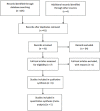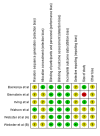The Effectiveness and Safety of Topical Capsaicin in Postherpetic Neuralgia: A Systematic Review and Meta-analysis
- PMID: 28119613
- PMCID: PMC5222862
- DOI: 10.3389/fphar.2016.00538
The Effectiveness and Safety of Topical Capsaicin in Postherpetic Neuralgia: A Systematic Review and Meta-analysis
Abstract
In particular, neuropathic pain is a major form of chronic pain. This type of pain results from dysfunction or lesions in the central and peripheral nervous system. Capsaicin has been traditionally utilized as a medicine to remedy pain. However, the effectiveness and safety of this practice is still elusive. Therefore, this systematic review aimed to investigate the effect of topical capsaicin as a pain-relieving agent that is frequently used in pain management. In brief, all the double-blinded, randomized placebo- or vehicle-controlled trials that were published in English addressing postherpetic neuralgia were included. Meta-analysis was performed using Revman® version 5.3. Upon application of the inclusion and exclusion criteria, only six trials fulfilled all the criteria and were included in the review for qualitative analysis. The difference in mean percentage change in numeric pain rating scale score ranges from -31 to -4.3. This demonstrated high efficacy of topical capsaicin application and implies that capsaicin could result in pain reduction. Furthermore, meta-analysis was performed on five of the included studies. All the results of studies are in favor of the treatment using capsaicin. The incidence of side effects from using topical capsaicin is consistently higher in all included studies, but the significance of safety data cannot be quantified due to a lack of p-values in the original studies. Nevertheless, topical capsaicin is a promising treatment option for specific patient groups or certain neuropathic pain conditions such as postherpetic neuralgia.
Keywords: Capsicum; capsaicin; pain; postherpetic neuralgia; topical agent.
Figures
Similar articles
-
A randomized vehicle-controlled trial of topical capsaicin in the treatment of postherpetic neuralgia.Clin Ther. 1993 May-Jun;15(3):510-26. Clin Ther. 1993. PMID: 8364943 Clinical Trial.
-
Profile of the capsaicin 8% patch for the management of neuropathic pain associated with postherpetic neuralgia: safety, efficacy, and patient acceptability.Patient Prefer Adherence. 2016 Sep 22;10:1913-1918. doi: 10.2147/PPA.S76506. eCollection 2016. Patient Prefer Adherence. 2016. PMID: 27703336 Free PMC article. Review.
-
NGX-4010, a high-concentration capsaicin patch, for the treatment of postherpetic neuralgia: a randomised, double-blind study.Lancet Neurol. 2008 Dec;7(12):1106-12. doi: 10.1016/S1474-4422(08)70228-X. Epub 2008 Oct 30. Lancet Neurol. 2008. PMID: 18977178 Clinical Trial.
-
Treatments for postherpetic neuralgia--a systematic review of randomized controlled trials.Fam Pract. 1996 Feb;13(1):84-91. doi: 10.1093/fampra/13.1.84. Fam Pract. 1996. PMID: 8671108
-
Topical capsaicin treatment of chronic postherpetic neuralgia.J Am Acad Dermatol. 1989 Aug;21(2 Pt 1):265-70. doi: 10.1016/s0190-9622(89)70171-7. J Am Acad Dermatol. 1989. PMID: 2768576 Clinical Trial.
Cited by
-
Multi-Spectroscopic and Theoretical Analysis on the Interaction between Human Serum Albumin and a Capsaicin Derivative-RPF101.Biomolecules. 2018 Aug 23;8(3):78. doi: 10.3390/biom8030078. Biomolecules. 2018. PMID: 30142945 Free PMC article.
-
Safety and Effectiveness of Bivalirudin in Patients Undergoing Percutaneous Coronary Intervention: A Systematic Review and Meta-Analysis.Front Pharmacol. 2017 Jul 11;8:410. doi: 10.3389/fphar.2017.00410. eCollection 2017. Front Pharmacol. 2017. PMID: 28744215 Free PMC article. Review.
-
Effect of intramuscular diazepam infusion on herpes zoster-related pain in older patients: a randomized, double-blind, placebo-controlled trial.BMC Anesthesiol. 2024 May 29;24(1):193. doi: 10.1186/s12871-024-02576-9. BMC Anesthesiol. 2024. PMID: 38811866 Free PMC article. Clinical Trial.
-
The efficacy of pregabalin for acute pain control in herpetic neuralgia patients: A meta-analysis.Medicine (Baltimore). 2017 Dec;96(51):e9167. doi: 10.1097/MD.0000000000009167. Medicine (Baltimore). 2017. PMID: 29390451 Free PMC article. Review.
-
Therapeutic Strategies for Postherpetic Neuralgia: Mechanisms, Treatments, and Perspectives.Curr Pain Headache Rep. 2023 Sep;27(9):307-319. doi: 10.1007/s11916-023-01146-x. Epub 2023 Jul 26. Curr Pain Headache Rep. 2023. PMID: 37493871 Review.
References
-
- Backonja M. M., Malan T. P., Vanhove G. F., Tobias J. K. (2010). NGX-4010, a high-concentration capsaicin patch, for the treatment of postherpetic neuralgia: a randomized, double-blind, controlled study with an open-label extension. Pain Med. 11 600–608. 10.1111/j.1526-4637.2009.00793.x - DOI - PubMed
-
- Basu S. K., Krishna A. D. (2003). “Capsicum: historical and botanical perspectives,” in Capsicum: The Genus Capsicum ed. Krishna A. D. (London: Taylor & Francis; ) 1–15.
Publication types
LinkOut - more resources
Full Text Sources
Other Literature Sources






